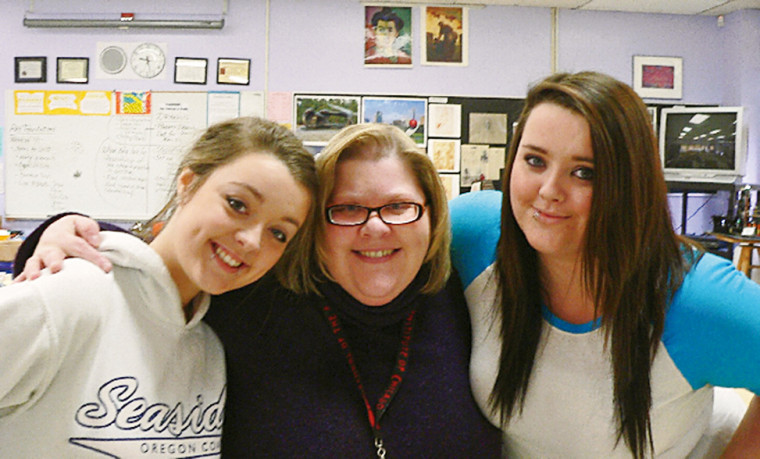Oregon’s Secondary Art Educator of the Year
Open gallery

As the high school drawing students take out their sketch pads, teacher Janice Packard MAT ’ 94 pulls out the art journal she compiled in college. The book is flagged with Post-it notes, marking examples of how her journal entries—her personal thoughts, observations, and sketches—grew into ideas that became pieces of art.
She tells them she played piano in college and points out a journal entry calling the music of Chopin tragically beautiful. Later, she explains, she married that concept with her drawings of snag trees left behind after a forest is clear-cut.
“Students love when teachers share their personal experiences,” she says. “I’m very honest with them.”
Packard’s students aren’t alone in noticing her passion for art and her creative teaching style. In October, the Oregon Art Education Association named her the state’s Secondary Art Educator of the Year for 2011.
“The award was totally unexpected,” says Packard. “It felt good being recognized by my colleagues who know what I do in the classroom and understand my teaching philosophy.”
Packard’s journey began as a student at Pacific Northwest College of Art in Portland. Inspired by her teachers, she became passionate about passing on the legacy of great teaching.
Shy at heart, Packard learned to give herself permission to occasionally get silly with her students and be a cheerleader in their corner. She developed techniques for teaching with subtlety, allowing students the joy of discovery.
It felt good being recognized by my colleagues who know what I do in the classroom and understand my teaching philosophy. Janice Packard MAT ’94
Later, at Lewis & Clark’s Graduate School of Education and Counseling, she found her voice in Greg Smith’s and Zaher Wahab’s teacher education classes, where she learned to analyze complex issues, frame effective arguments, and engage in spirited debate. Exposed to a wide range of ideas and educational philosophies in prepracticum coursework, she discovered what she cared about and how she wanted to teach.
“I’ve come to understand that all of the arts are essential to us as human beings,” says Packard. “They mirror what’s happening in the world and can be a catalyst for change. The arts teach problem solving, critical thinking, and tolerance for a wide array of ideas and approaches—skills and qualities that are valuable in any profession.
“Practicing art develops confidence, discipline, character, teamwork, and observation and imagination skills. Because it’s an emotion-based subject, students need to draw on their own experiences, beliefs, and inner life to express an idea.”
The arts teach problem solving, critical thinking, and tolerance for a wide array of ideas and approaches—skills and qualities that are valuable in any profession. Janice Packard MAT ’94
In Estacada, Packard teaches beginner to advanced classes. Students learn basic skills and principles, then graduate to theme-based projects and portfolio building. Packard enthusiastically encourages students to participate in art festivals and competitions, especially juried art shows.
“The experience helps them understand what it’s like to be a professional artist,” she says. “It builds a sense of community among students.”
As a teacher, Packard believes that the best art programs are led by educators who continue their own studio work. Packard works in a variety of two- and three-dimensional media. Her painting style is a mixture of expressionism and surrealism. She paints primarily in oils but has started experimenting with mixed media.
“Being a working artist brings authenticity to my teaching,” she says. “The students see me experiencing an artist’s joy and angst. I talk to them about my successes and struggles. It helps us relate to each other.”
—by Pattie Pace
More L&C Magazine Stories
Lewis & Clark Magazine is located in McAfee on the Undergraduate Campus.
MSC: 19
email magazine@lclark.edu
voice 503-768-7970
fax 503-768-7969
The L&C Magazine staff welcomes letters and emails from readers about topics covered in the magazine. Correspondence must include your name and location and may be edited.
Lewis & Clark Magazine
Lewis & Clark
615 S. Palatine Hill Road MSC 19
Portland OR 97219

